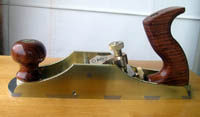philosofriend
Tele-Afflicted
When I got a pair of very coarse and very fine diamond sharpening stones I learned that my previous methods of flattening things were nowhere as good as I thought. The diamond plates are 1/4 inch thick with the diamond dust attached by electroplated nickel. When you disassemble a plane there are a lot of parts that are supposed to be flat. The diamond stones can be used with water and dish soap to remove rust and dirt and start the sharpening process. This saves a lot of time. They are kind of expensive. You can use them to flatten traditional sharpening stones.
Once you get the inner parts of the plane clean, flat and oiled, it becomes much easier to adjust the plane to a very fine degree to best tackle the particular wood/grain issues of the job at hand.
Once you get the inner parts of the plane clean, flat and oiled, it becomes much easier to adjust the plane to a very fine degree to best tackle the particular wood/grain issues of the job at hand.


